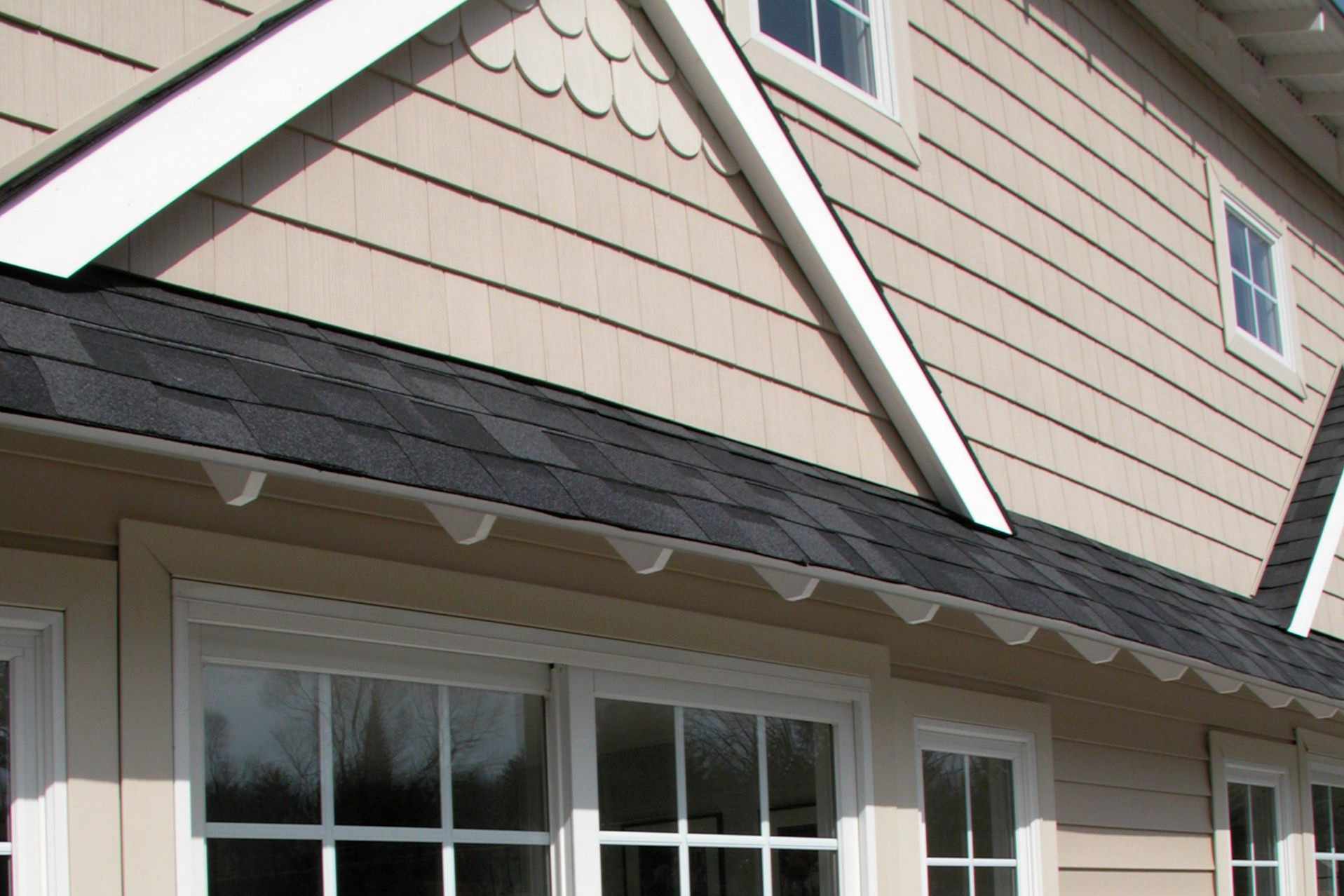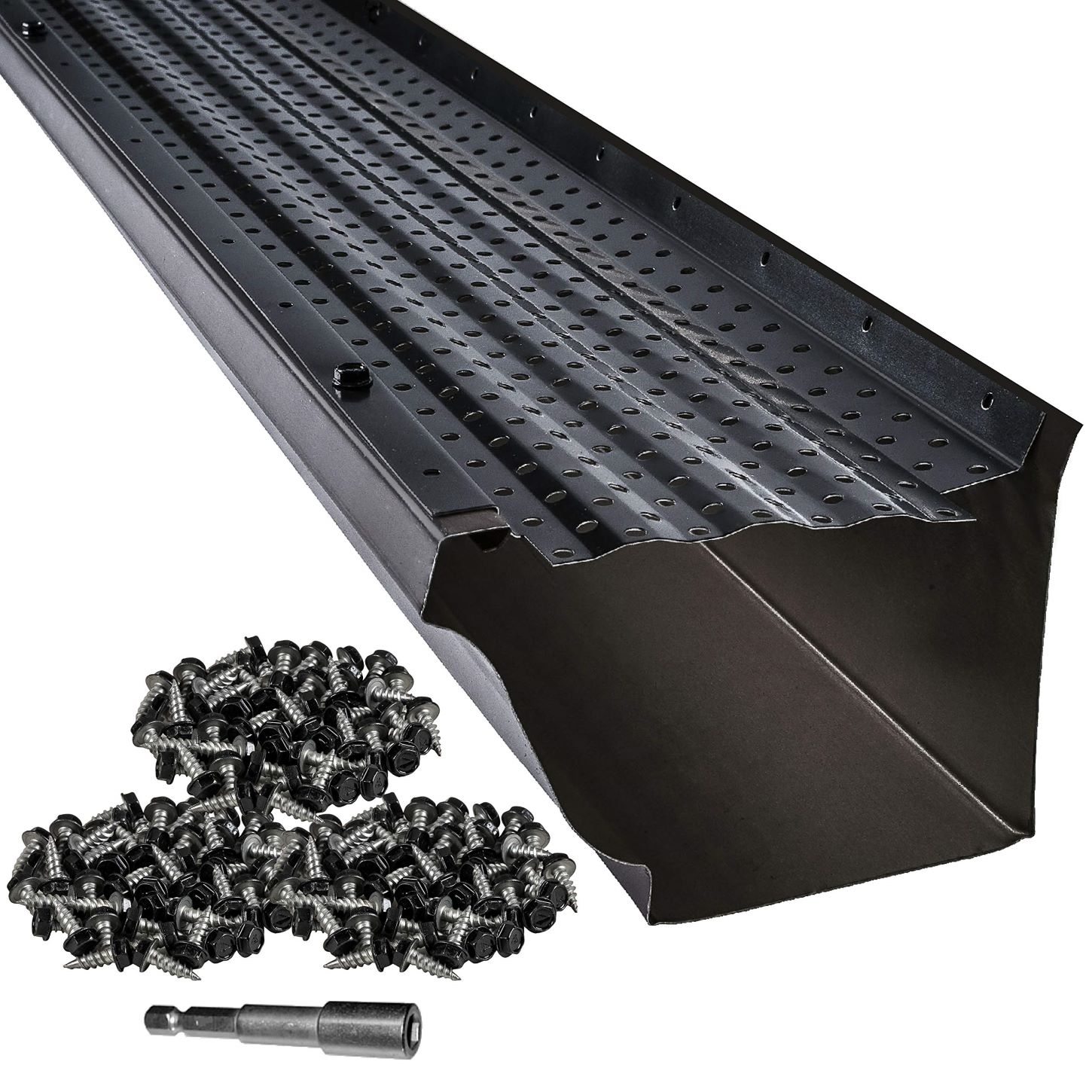

Articles
How Do You Tell If I Have 5 Or 6 Inch Gutters
Modified: October 20, 2024
Learn how to determine if you have 5 or 6 inch gutters with our informative articles on gutter sizes and installation.
(Many of the links in this article redirect to a specific reviewed product. Your purchase of these products through affiliate links helps to generate commission for Storables.com, at no extra cost. Learn more)
Introduction
Gutters play a crucial role in managing water runoff from your roof and protecting your home’s foundation from potential damage. When it comes to choosing the right gutters for your home, size matters. The most common gutter sizes are 5-inch and 6-inch, but how do you tell which size is suitable for your needs? In this article, we will delve into the key differences between 5-inch and 6-inch gutters and discuss how to determine which size is best for your home.
Before we dive into the specifics, let’s start with a basic understanding of what gutters are and why they are important. Gutters are channels installed along the edge of a roof to collect rainwater and direct it away from the foundation. This helps prevent water damage to the roof, walls, and foundation, as well as erosion in the surrounding landscape.
When it comes to gutter sizes, there are two primary options: 5-inch and 6-inch gutters. The size refers to the width of the gutter trough. While both sizes can effectively handle water runoff, they have distinct differences in terms of capacity and performance.
Understanding the difference between 5-inch and 6-inch gutters is essential for making an informed decision. Factors such as the average annual rainfall in your area, the pitch and size of your roof, the number of downspouts, and the type of debris that tends to accumulate in your gutters can all play a role in determining the appropriate size for your home.
In the next sections, we will explore the signs that indicate the need for 5-inch gutters and those that suggest 6-inch gutters are more suitable. We will also discuss how to accurately measure your gutters to ensure you choose the right size for your specific requirements. By the end of this article, you will have a comprehensive understanding of when to opt for a 5-inch or a 6-inch gutter system.
Key Takeaways:
- Understanding the differences between 5-inch and 6-inch gutters is essential for choosing the right size based on factors such as roof pitch, rainfall, and debris accumulation. Accurate measurements and professional advice ensure optimal gutter performance.
- Signs such as average rainfall, roof size, and budget constraints can indicate whether 5-inch or 6-inch gutters are more suitable for a home. Consulting with a professional gutter installer is crucial for making an informed decision.
Read more: How Much Do 6 Inch Gutters Cost
What are gutters?
Gutters are an essential component of residential and commercial buildings that help manage rainwater runoff. They are troughs that are typically made of aluminum, steel, vinyl, or copper and are attached along the edges of the roofline. The main purpose of gutters is to collect rainwater that falls on the roof and direct it away from the foundation of the building.
By collecting and redirecting rainwater, gutters prevent water from pooling on the roof, seeping into the walls, or causing damage to the foundation. Without gutters, rainwater can cause a variety of problems, including roof leaks, basement flooding, soil erosion, and even structural damage to the building.
Gutters work in tandem with downspouts, which are vertical pipes connected to the gutters. The downspouts help channel the collected water from the gutters down to the ground or into a drainage system. This ensures that water is effectively directed away from the building, reducing the risk of water damage.
There are several types of gutters available on the market, including sectional gutters and seamless gutters. Sectional gutters are made up of smaller sections that are pieced together, while seamless gutters are custom-made to fit the exact measurements of the roofline without any joints or seams.
Gutters come in various sizes, with the two most common being 5-inch and 6-inch gutters. The size of the gutters refers to the width of the trough. This measurement is important because it determines the capacity of the gutter system to handle a certain volume of water.
In addition to their functional significance, gutters can also enhance the aesthetic appeal of a building. They are available in different styles and colors to complement the architecture and design of the structure. Properly installed and well-maintained gutters not only provide protection against water damage but also add value to the property.
In summary, gutters are a vital part of any building’s drainage system. They collect rainwater and direct it away from the foundation, preventing water-related issues. By understanding the purpose and importance of gutters, you can effectively choose the right size and type for your specific needs, ensuring the long-term integrity and stability of your property.
Understanding gutter sizes
When it comes to selecting gutters for your home, understanding the different sizes available is essential. Gutters come in several sizes, but the two most common options are 5-inch and 6-inch gutters. The size refers to the width of the gutter trough, which impacts the capacity and performance of the gutter system.
5-inch gutters are the standard choice for most residential properties. They are suitable for average rainfall conditions and work well for roofs with a moderate pitch. These gutters can handle a significant amount of rainfall and effectively divert water away from the roof and foundation. 5-inch gutters are more budget-friendly and easier to install due to their smaller size.
On the other hand, 6-inch gutters are often recommended for homes located in areas with high rainfall or steeply pitched roofs. The larger width of the gutter trough allows for greater water capacity, reducing the risk of overflow during heavy rainstorms. 6-inch gutters are more commonly used for commercial buildings or homes with extensive roof surfaces that generate a large volume of water runoff.
Choosing the right gutter size depends on a variety of factors. The average annual rainfall in your area plays a significant role in determining the appropriate gutter size. If you live in a region with heavy rainfall, opting for 6-inch gutters can help ensure that your gutter system can handle the increased water flow.
The pitch and size of your roof also impact the choice of gutter size. Steeply pitched roofs tend to generate more runoff, which requires a larger gutter system to handle the increased volume. Additionally, homes with larger roof surfaces may benefit from 6-inch gutters to accommodate the greater amount of water flow.
The number of downspouts also affects the choice of gutter size. Downspouts are responsible for directing the water from the gutter trough to the ground or drainage system. Larger gutter sizes may require additional downspouts to efficiently handle the water flow and prevent overflow.
It’s important to consider the type of debris that tends to accumulate in your gutters when choosing the gutter size. If you live in an area with many trees or where leaves and debris are prevalent, larger gutters may be beneficial as they are less likely to clog and require frequent cleaning.
In summary, understanding gutter sizes is crucial for selecting the right gutters for your home. While 5-inch gutters are the standard choice, 6-inch gutters are recommended for areas with high rainfall or steeply pitched roofs. Factors such as annual rainfall, roof pitch and size, the number of downspouts, and debris accumulation should all be considered to ensure optimal performance and functionality of your gutter system.
The difference between 5-inch and 6-inch gutters
When choosing gutters for your home, understanding the differences between 5-inch and 6-inch gutters is crucial. While both sizes serve the same purpose of collecting and redirecting rainwater, they have distinct characteristics that can impact their performance and suitability for your specific needs.
The main difference between 5-inch and 6-inch gutters lies in their width. A 5-inch gutter has a trough width of 5 inches, while a 6-inch gutter has a trough width of 6 inches. The larger width of the 6-inch gutter allows for greater water capacity, which is particularly beneficial in areas with high rainfall or roofs with a steep pitch.
One of the primary advantages of 5-inch gutters is their affordability and ease of installation. Since they are smaller in size, 5-inch gutters tend to be less expensive than their 6-inch counterparts. Additionally, their smaller size makes them easier to handle during the installation process. If your home experiences average rainfall or has a roof with a moderate pitch, 5-inch gutters can effectively handle water runoff.
On the other hand, 6-inch gutters are recommended for homes located in regions with heavy rainfall or roofs with a steeper pitch. The larger width of these gutters allows for a greater volume of water to flow through, reducing the risk of overflow during intense rainstorms. This can help prevent water damage to the roof, walls, and foundation of your home.
Another factor to consider when comparing 5-inch and 6-inch gutters is the number of downspouts required. Downspouts are responsible for directing the water from the gutter system to the ground or drainage system. Since 6-inch gutters have a higher water capacity, they may require fewer downspouts compared to 5-inch gutters. However, this will depend on the specific layout and size of your home, as well as local building codes.
It’s important to note that while 6-inch gutters can handle a greater volume of water, they may not be necessary for all homes. Factors such as annual rainfall, roof pitch, roof size, and debris accumulation should all be considered when determining the appropriate gutter size for your specific needs. Consulting with a professional gutter installer can help ensure you choose the right size for optimal functionality and performance.
In summary, the key difference between 5-inch and 6-inch gutters lies in their width and water capacity. 5-inch gutters are more affordable and suitable for average rainfall conditions, while 6-inch gutters are recommended for areas with high rainfall or steeply pitched roofs. Considering factors such as annual rainfall, roof size, and debris accumulation will help you make an informed decision and choose the right gutter size for your home.
Factors to consider in determining the gutter size
Choosing the right gutter size for your home requires careful consideration of various factors. While 5-inch and 6-inch gutters are the most common options, determining the appropriate size involves assessing specific elements related to your property and environmental conditions. Here are some key factors to consider:
- Rainfall: The average annual rainfall in your area plays a significant role in determining the gutter size. If you live in a region with frequent heavy rainstorms, opting for a larger gutter size, such as 6-inch gutters, can help accommodate the increased volume of water. However, if you experience average rainfall, 5-inch gutters may be sufficient.
- Roof pitch and size: The pitch and size of your roof influence the amount of water runoff generated. Steeply pitched roofs tend to produce a higher volume of water flow, necessitating a larger gutter system. Similarly, larger roofs may require larger gutters to effectively handle the increased water load. Consider the slope and dimensions of your roof when determining the appropriate gutter size.
- Number of downspouts: Downspouts are crucial for channeling water from the gutters to the ground or drainage system. The number of downspouts needed depends on the gutter size as well as the roof size. Larger gutter sizes, such as 6-inch gutters, can handle more water flow, potentially reducing the number of necessary downspouts. Assess your property’s layout and the local building codes to determine the optimal number of downspouts for your gutter system.
- Debris accumulation: The type and amount of debris that tend to accumulate in your gutters should also influence your decision. If you live in an area with many trees or where leaves and debris are prevalent, larger gutter sizes may be more suitable. The larger capacity of the gutters can help prevent clogging and reduce the frequency of gutter cleaning and maintenance.
- Budget and installation: Consider your budget and installation constraints when selecting the gutter size. 5-inch gutters are generally more affordable and easier to install due to their smaller size. On the other hand, 6-inch gutters may require a slightly higher investment but can provide better performance in areas with heavy rainfall. Evaluate your budget and consult with professional installers to determine the most cost-effective and practical option for your home.
Taking all these factors into account will help you make an informed decision about the appropriate gutter size for your home. It’s important to remember that every property is unique, and the optimal gutter size may vary. Consulting with a professional gutter installer can provide expert advice tailored to your specific requirements and ensure that you choose a gutter size that effectively manages water runoff and protects your home from potential damage.
Measure the width of the gutter. 5-inch gutters are typically 4 1/4 inches wide, while 6-inch gutters are typically 5 1/4 inches wide.
Read more: How To Tell If I Have A Surge Protector
Signs that indicate 5-inch gutters
While 6-inch gutters may be necessary for certain situations, there are several signs that indicate 5-inch gutters are a suitable choice for your home. Understanding these signs can help you make an informed decision when selecting the appropriate gutter size. Here are some indicators that 5-inch gutters may be the right option:
- Average rainfall: If you live in an area with moderate or average rainfall, 5-inch gutters can effectively handle the water flow. These gutters are suitable for homes in regions where heavy rainstorms are less common. Assess the typical weather patterns in your area and consider the average amount of annual rainfall to determine if 5-inch gutters would be sufficient.
- Modest roof pitch: The pitch of your roof influences the rate of water runoff. If you have a roof with a moderate slope, 5-inch gutters can adequately manage the water flow. Steeply pitched roofs tend to generate more runoff, but if your roof has a moderate pitch, 5-inch gutters should be able to handle the volume of water without overflowing.
- Smaller roof area: If your home has a relatively small roof surface area, 5-inch gutters should suffice. Homes with less roof area generate less water runoff, making smaller gutters suitable for managing the lower volume of water. Assess the size of your roof to determine if 5-inch gutters are appropriate.
- Restricted budget: If budget constraints are a consideration, 5-inch gutters are generally more affordable compared to 6-inch gutters. The smaller size of 5-inch gutters translates to lower material and installation costs. If you’re looking for a cost-effective option without compromising functionality, 5-inch gutters can provide an excellent solution.
- Minimal debris accumulation: If you live in an area with minimal tree coverage or limited debris accumulation, 5-inch gutters should be sufficient. These gutters can handle moderate amounts of debris without getting clogged. However, regular maintenance and cleaning are still necessary to ensure proper functioning.
Keep in mind that these signs are general indicators, and it’s essential to evaluate your specific circumstances. Assessing factors such as average rainfall, roof pitch, roof size, budget, and debris accumulation will provide a holistic understanding of whether 5-inch gutters are suitable for your home.
Consulting with a professional gutter installer is highly recommended. They can assess your property, consider the local climate conditions, and provide expert guidance on the optimal gutter size for your specific needs. This will ensure that you choose the right gutter size that effectively manages water runoff and protects your home from potential water damage.
Signs that indicate 6-inch gutters
While 5-inch gutters are suitable for many homes, there are certain signs that indicate 6-inch gutters may be the right choice for your property. These signs suggest that a larger gutter size is needed to effectively manage water runoff. Here are some indicators that 6-inch gutters may be the appropriate option:
- High rainfall area: If you live in an area with frequent heavy rainfall, 6-inch gutters are recommended. The larger width of these gutters allows for a higher water capacity, ensuring that they can handle the increased volume of water flow during intense rainstorms. This helps prevent overflow and potential water damage to your home.
- Steeply pitched roof: Roofs with a steep pitch tend to generate a greater amount of water runoff. In such cases, 6-inch gutters are more suitable as they can handle the increased water flow. The larger size ensures that water is effectively collected and directed away from the roof and foundation, reducing the risk of water-related issues.
- Large roof area: Homes with extensive roof surfaces produce a significant volume of water runoff. If your property has a large roof area, 6-inch gutters are recommended to accommodate the higher water load. These gutters provide the necessary capacity to manage the larger volume of water and help prevent overflow.
- Multiple downspouts: Larger gutter sizes, such as 6-inch gutters, may require fewer downspouts compared to their 5-inch counterparts. If your home requires a significant number of downspouts to handle the water flow, opting for 6-inch gutters can help streamline the gutter system and reduce the number of necessary downspouts.
- Significant debris accumulation: If you live in an area with many trees or where debris tends to accumulate rapidly, 6-inch gutters may be more suitable. The larger size of these gutters can better handle the increased debris load, reducing the risk of clogs and ensuring efficient water flow. Regular cleaning and maintenance are still necessary to keep the gutters functioning optimally.
Keep in mind that these signs are general indicators, and it’s important to assess your specific circumstances. Consider factors such as average rainfall, roof pitch, roof size, number of downspouts, and debris accumulation when determining if 6-inch gutters are the right choice for your home.
It is highly recommended to consult with a professional gutter installer. They can assess your property, consider the local climate conditions, and provide expert recommendations tailored to your specific needs. Their expertise will ensure that you choose the appropriate gutter size that effectively manages water runoff and protects your home from potential water damage.
How to measure your gutters accurately
Accurately measuring your gutters is essential when determining the appropriate size for replacement or installation. By following these steps, you can ensure that you get the right measurements and choose the correct gutter size for your home:
- Prepare the necessary tools: Before you begin measuring your gutters, gather the tools you will need. These may include a tape measure, ladder, pencil, paper, and a calculator.
- Set up the ladder safely: Place the ladder securely on a level surface and ensure that it is stable. Take necessary precautions and follow safety guidelines to prevent any accidents or injuries.
- Start at one end of the gutter: Begin at one end of the gutter system and measure the width from one inside edge to the opposite inside edge. This measurement should be taken at the spot where the gutter attaches to the fascia.
- Measure the downspout width: If you are replacing or installing downspouts, measure the width of the existing downspouts. This will help determine the appropriate size for the new downspouts if you plan to replace them as well.
- Continue measuring along the gutter: Move along the length of the gutter, measuring the width at various points. Note down these measurements as you go. It’s important to measure at multiple points since gutter widths can vary due to factors such as installation inconsistencies or shifting.
- Measure the height of the gutter: In addition to the width, measure the height of the gutter. This is the distance from the bottom of the trough to the top outer edge. This measurement is important if you plan on replacing the entire gutter system.
- Calculate the average measurement: Once you have measured the width at multiple points, calculate the average width by adding all the measurements together and dividing by the number of measurements. This will give you a more accurate representation of the gutter width.
- Consider additional factors: While measuring the width is crucial, it is also essential to consider other factors, such as roof size, pitch, average rainfall, and debris accumulation. These factors will help determine the appropriate gutter size for optimal functionality.
- Consult with a professional: If you are unsure about taking accurate measurements or have specific requirements, it is always a good idea to consult with a professional gutter installer. They have the expertise to accurately assess your gutter needs and provide guidance on the appropriate size for your home.
By following these steps and ensuring accurate measurements, you can confidently choose the right size gutters for your home. Remember, precise measurements are essential for optimal performance and functionality of your gutter system.
Conclusion
Selecting the right gutter size is crucial for effectively managing water runoff and protecting your home from potential damage. Understanding the differences between 5-inch and 6-inch gutters and considering various factors will help you make an informed decision.
For homes located in areas with average rainfall, moderate roof pitches, and smaller roof areas, 5-inch gutters are generally suitable. These gutters are more affordable, easier to install, and can effectively handle the water flow under normal circumstances.
On the other hand, 6-inch gutters are recommended for homes in areas with heavy rainfall, steeply pitched roofs, and larger roof surfaces. The larger capacity of these gutters enables them to handle higher volumes of water, reducing the risk of overflow and potential water damage.
Factors such as roof pitch, roof size, average rainfall, debris accumulation, and budget should all be considered when determining the appropriate gutter size. Moreover, accurately measuring your gutters is essential in order to choose the right size that will ensure optimal functionality and performance.
Don’t hesitate to consult with a professional gutter installer who can assess your specific needs, provide expert advice, and ensure that you select the most suitable gutter size for your home. Their knowledge and experience will ensure that your gutter system effectively manages water runoff and protects your home for years to come.
By carefully considering these factors and making an informed decision, you can ensure the longevity and integrity of your home’s foundation while keeping it safe from water-related issues. Remember, proper gutter sizing is a crucial investment in protecting your property and maintaining its value over time.
Frequently Asked Questions about How Do You Tell If I Have 5 Or 6 Inch Gutters
Was this page helpful?
At Storables.com, we guarantee accurate and reliable information. Our content, validated by Expert Board Contributors, is crafted following stringent Editorial Policies. We're committed to providing you with well-researched, expert-backed insights for all your informational needs.















0 thoughts on “How Do You Tell If I Have 5 Or 6 Inch Gutters”